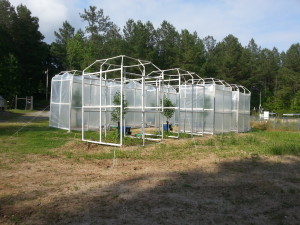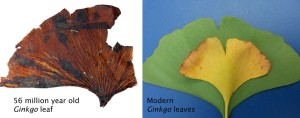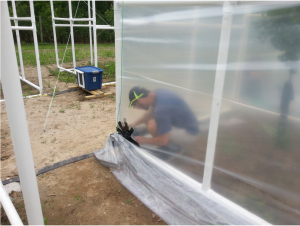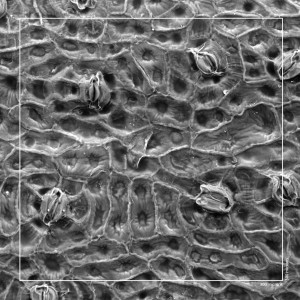by Joe Dawson, science writing intern
Looking at the Kirkpatrick Marsh on the Rhode River, a time machine is not the first thing that comes to mind. Tall grasses dominate the landscape, with vertical PVC pipes popping up here and there and octagon-shaped chambers rising out of the wetland every ten paces or so. Take a step off the walkway, and you might lose a shoe. But five experiments on the marsh are designed to take sections of the marsh into the 22nd Century, and the marsh has been dubbed the Global Change Research Wetland, or GCReW. The expertise that GCReW scientists have in simulating the future brought National Museum of Natural History scientists here to mirror the past.
Rich Barclay and Scott Wing are paleobotanists at the National Museum of Natural History. Paleobotanists are the ones who stare at leaves in Jurassic Park and say, “Alan, these plants haven’t been seen since the Cretaceous Period,” as everyone else stares at brachiosauruses. Ancient plants are their bread and butter, and for Wing and Barclay, the bread is toasted and the butter melty. They study one of the warmest periods in the last 100 million years, the Paleocene-Eocene Thermal Maximum (PETM). During this period, global temperatures skyrocketed, increasing by 10-15 degrees Fahrenheit. By looking at plants that grew during this time, they hope to learn more about what Earth was like 55 million years ago.

Large growth chambers being built around newly-planted ginkgo trees on the SERC campus (Credit: Rich Barclay)
Barclay, Wing, and colleagues have started another experiment on the Smithsonian Environmental Research Center’s (SERC) campus, in a forest a few miles down the road from the GCREW marsh. The project grows ginkgo trees in varying carbon dioxide levels. They hope to study these trees and compare them to fossil specimens to learn about the past.
Ginkgoes in the Past, Ginkgoes in the Future
They have found a great subject for their study, the ginkgo tree. Ginkgoes are living fossils, meaning they exist today much as they have existed for hundreds of millions of years. Even better, ginkgo leaves preserve well in the fossil record.
“There are some specimens you can literally peel off the rock and wave it around in your hands, and you’d swear that if it wasn’t brown and came from a 50 million-year-old rock that you could have just picked it up off the ground,” says Barclay.

Ginkgo leaves (Credit: Rich Barclay)
These paleobotanists wanted to know how much carbon dioxide was in the atmosphere during the PETM. Pores on a ginkgo leaf act like a carbon dioxide barometer: As carbon dioxide levels increase, the number of pores in a leaf goes down. This understanding led scientists to the conclusion that during the PETM, carbon dioxide levels were higher than before, and that they fell afterward. Coming up with exact carbon dioxide levels, however, was tough.
“CO2 has been really hard to quantify during those same intervals [hot ones],” says Barclay.
To read fossil ginkgoes, Barclay, Wing, and their colleagues from SERC are recreating the conditions in which they formed. “That’s the way to look into the future, to use the modern plants to tell us what was going on in the past, to understand those, then compare it to the present,” says Barclay.
Scientists have carried out similar experiments in greenhouses before, but Barclay and Wing wanted to create an experiment in a natural environment, where the ginkgoes would grow in all the natural fluctuations in temperature, rainfall, wind, and light. Greenhouses and grow lights aren’t great for getting a good picture of a whole ecosystem, according to Barclay. “By controlling everything, you’ve created an unnatural situation,” he says.
To get their experiment off the ground, Wing and Barclay needed some expertise on CO2 experiments. Scientists at SERC’s favorite futuristic wetland, GCReW, have been performing natural-environment carbon dioxide experiments for thirty years on wetland plants and ecosystems. Barclay says that SERC “was a natural place to do it.”
Watch: Scientists wrap greenhouse plastic around growth chambers. The chambers have open tops, so that air can circulate and rain can enter, but carbon dioxide levels will stay elevated (Video credit: Rich Barclay).
Wing and Barclay set up their experiment in a forest clearing. To test specific responses of ginkgo trees to different levels of carbon dioxide, researchers at SERC helped Barclay build a set of chambers large enough to grow full-sized ginkgo trees in. Some trees are grown without any extra carbon dioxide, at modern-day ambient levels of about 400 parts per million. Huge metal tanks of carbon dioxide push the carbon dioxide concentrations for the other trees up to three different levels: 600, 800, and 1000 parts per million.
SERC director of research Pat Megonigal helped organize the collaboration and infrastructure for the project, while long-time GCReW environmental engineer Gary Peresta assisted the construction of the chambers and the design and installation of the gas distribution and monitoring system. Postdoctoral researcher Grace Cott eagerly joined in the engineering process, as her current and future research uses the same systems to predict what might happen to plant-environment interactions in the future.
Cott’s studies are more concerned about the future than the past, but she thinks this experiment can help us learn about both.

SERC intern Jason Swartz helps construct the carbon dioxide delivery system in one of the ginkgo chambers (Credit: Rich Barclay)
“It’s so important to establish how the natural environment is responding to global change factors, in particular high levels of CO2,” she says. “They’re going to increase. We’re continuing to emit huge amounts of CO2. Establishing how the natural environment responds is really, really important.”
Many Hands Make Light Work
Once the ginkgoes have grown in their carbonated chambers, scientists from the Natural History Museum and volunteers mount modern and fossil ginkgo leaves and photograph them with a high-powered microscope. Someone must count both the cells and the pores in each leaf. That ends up being a ton of counting.
“There are literally thousands of images to try and count,” says Barclay. That used to be his job. “There’s always a bottleneck in whatever kind of scientific endeavor you’re involved in. For us, it tends to be the counting of the images.”
Enter the citizen scientists. With the help of the online platform Zooniverse, professional scientists have given anyone with an internet connection the opportunity to participate in their research. Laura Soul, a Peter Buck Deep-Time postdoctoral fellow at the National Museum of Natural History, captained the effort to set up the citizen science portal and worked to make the experience as user-friendly as possible.

An example of a scanning electron microscope (SEM) image of a ginkgo leaf. The leaf pores are the structures shaped like lips, and citizen scientists count them along with the number of total cells within the white box (Photo courtesy of Rich Barclay).
Citizen scientists tackle the mountain of images one at a time, labeling the pores and counting the total number of cells. They log on, get a five-minute tutorial on identifying pores and cells, and can immediately get to work analyzing experimental images. It’s not enthralling, but it suits a certain temperament. Some volunteers have told Barclay and Soul that it is meditative; one user worked through all the samples, 900 images, and asked if there were any more to analyze.
Citizen science doesn’t just keep Barclay from going crazy staring at leaf images. It provides a second-to-none form of science outreach by getting people on the outside involved in the day-to-day operations of science.
“In terms of communicating the scientific process, I think it’s unrivaled,” says Soul. Getting people involved with the methods gives them insight into the scientific process beyond reading or learning about science second-hand.”When people are actually doing science with you, it’s much easier for them to engage with how it works, the reality of science.”
Getting citizen scientists invested in the project will help with the next phase, collecting and processing modern samples from around the world. Fifteen trees growing in Maryland will give the scientists a good idea of how carbon dioxide affects ginkgoes, but hundreds of trees from around the world can help them understand the exact relationship between pores, carbon dioxide, moisture, latitude, temperature, and other variables. Volunteers who get hooked on ginkgo research by analyzing leaves online may be able to contribute even more in the future, by mailing in ginkgo leaves to the Smithsonian along with information about where the sample was taken.
With the help of citizen scientists, a dozen growth chambers in Maryland, and perhaps a ginkgo tree growing on your street, professional scientists may get a peek at the past, with or without a time machine.

